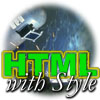A Web is Born
 A Web is Born
A Web is Born
One fine day, in the European Laboratory for Particle Physics, a man called Tim Berners-Lee came up with this idea of something that came to be called the World Wide Web.
The problem faced at the time was that while everyone was starting to use the Internet to communicate, the information available on the Internet was not organized, presented or connected in any consistent way. The idea Tim Berners-Lee had was based on hypertext technology (see Tutorial2), and was called the World Wide Web. The goal of the World Wide Web is to gather and organize as much information as possible in a way that is easily accessible and easy to find by people through computers. The World Wide Web consisted of three main parts:
- UDIs (Universal Document Identifiers) - these later came to be called Universal Resource Identifiers, or URIs. I covered URIs extensively in Tutorial 2. The purpose of URIs is to identify any piece of information, locate it and find a way to retrieve it.
- HTML, the HyperText Markup Language. This is the stuff I'm trying to teach you. HTML is meant to be a simple document creation language suitable for online transmission and powerful linking. This is the important bit, so I'll run it by you one more time: HTML is meant to represent simple documents so that they can be transmitted over a network and linked to each other.
- HTTP, the HyperText Transfer Protocol. This is a mechanism used to transfer (primarily) HTML documents over the network. Most Web authors don't need to bother with HTTP since it runs in the background and makes sure your Web pages get to those who want to recieve them.
These three technologies have since evolved in parallel. UDIs became URIs which split into URLs and URNs, HTTP has come of age at the ripe version of 1.1, and HTML... well, HTML is another story.
The main problem with HTML is that nobody was ever quite sure what it was supposed to do and what it wasn't supposed to do. When the World Wide Web was still making its first shy steps into the world, HTML was generally written according to a rough consensus of what it should be and developed on the fly every time a new Web browser came along. This rough consensus can be gleaned by reading various informal guides of the time (the early 90s, ancient history in computer terms) and is generally placed under the heading of HTML 1.0. There never really was a version 1.0, since at the time the technology was too fluid, but that's the name we use to refer to the early stages of HTML.
However, this approach could not survive so long when the Web started gaining a wider audience.
Produced by Stephanos Piperoglou
All Rights Reserved. Legal Notices.
URL: https://www.webreference.com/html/tutorial4/1.html
Created: July 12, 1998
Revised: July 12, 1998





 Find a programming school near you
Find a programming school near you